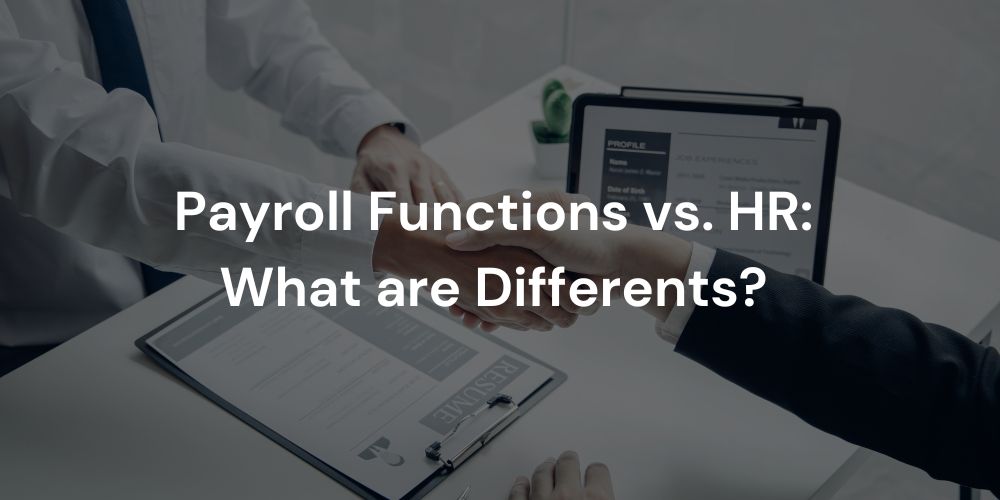Payroll Functions vs. HR: What are Different?


HR and Payroll Service divisions perform very different functions for a company. While human resources are frequently in charge of managing employee relations, payroll functions control employee salary. However, in small businesses, the two responsibilities frequently overlap and are carried out by the same person. On paper, this system appears advantageous because there are fewer people to pay and an integrated approach to the company’s operation. Still, it can occasionally cause a variety of problems.
A business leader must understand the differences between the two activities’ responsibilities and how they can work together to achieve the best results.
What is the Payroll Functions?
Paying employees’ salaries or wages is referred to as payroll. The payroll department processes taxes and other deductions, matches payroll information with accounting systems, and ensures that money reaches employees on time.
Calculating bonuses, expenses (for travel, mileage, food, and so on), paid holidays, overtime, and other payments due on a weekly, monthly, or annual basis are all part of the payroll run. The payroll team oversees recordkeeping, wage reductions, and verifying first payment information. The payroll division is also responsible for ensuring that each employee receives a pay slip once their salary has been processed.
Read more: Top 10 Payroll Tips for Small Business Owners
What is the HR Function?
HR’s primary responsibilities include:
- The administration of all personnel within the company.
- Bringing out the best in them.
- Ensuring that the company complies with labor laws and regulations.
Human Resources, also known as HR, is in charge of hiring new employees for the company. Employee departures, which they are also responsible for managing, or a new position due to company expansion.
HR is also in charge of overseeing how employees behave at work and occasionally off-site. This may include social media and other external influences, depending on the technology or the person’s position.
They must also ensure that training is available when needed. Employees who are not properly trained for the positions for which they have been hired cost money. The same can be said for unorganized training.
The HR department typically upholds corporate policy and adds to it as the company grows.
The HR department develops motivational programs and cultural changes to ensure everyone who works for the organization enjoys their job. The HR department wants to help employees advance in their careers by allowing them to shine in their chosen roles and assisting them as needed.
Human resource management services also cover various responsibilities, such as hiring, developing, and implementing HR policies to engage employees or promote specific company culture, performance management, and the internal implementation of employment legislation. It also includes transactional tasks such as creating reports, gathering HR information, dealing with pay issues, and keeping track of employee information.
The Overlap of HR vs. Payroll Functions
The HR and Payroll functions must work well together to function properly. The HR department hires (or fires) employees and registers them on the system. Following that, payroll takes over, ensuring that all aspects of their payments are handled.
HR and payroll keep track of sick, vacation, and other leave balances; the data is forwarded to managers and supervisors, who are then in charge of organizing time off requests efficiently.
Confidentiality is one area where the combined efforts of HR and Payroll will significantly improve. Both agencies have access to personal information about employees, such as Social Security numbers, financial information, and residential addresses. HR and payroll have a joint responsibility to keep sensitive information out of the hands of unauthorized individuals.
Human Resources vs. Payroll Services
The line between the teams that process employee pay, and those that make pay decisions is thin.
It can be difficult to tell them apart at times. HR and payroll differ primarily in their understanding of people or money. However, it makes little difference when payroll is the activity that connects resources to individuals.
It is simple to tell the difference between payroll and human resources; it all comes down to the jobs each “department” in your company performs.
Payroll primarily concerns compensating people for performing their jobs according to specifications. HR is in charge of finding the best candidate for each position.
There are many other variations, but that is how people generally differ within a corporation.
However, there are numerous instances where the jobs overlap. As a result, they are frequently grouped in workplaces.
Direct communication between the Payroll and Human Resources departments is sometimes required. One is the start or end date of a new employee’s employment.
Employees may also be given a pay increase in other situations, such as when promoted. It is also required for those who wish to take yearly or other types of leave, such as PPL.
Furthermore, it is well-known that in some small business settings, the HR and payroll functions are performed by the same person. This helps to reduce business costs because there isn’t enough work for everyone in each job.
The most significant distinction between HR and Payroll functions is the types of people hired for these positions, as both require very different skill sets. Payroll is a finance-related position that requires in-depth knowledge of accounting procedures, tax legislation, and a strong command of numbers. Those working in the payroll department should therefore have a strong sense of logic and an aptitude for mathematics.
Because the HR department’s primary focus is on people management and organization, those who are organized, have strong communication skills, and enjoy interacting with people are best suited for this profession.
Payroll and HR Integration
HR vs. Payroll requirements increase as a business grows from a micro to a small to a medium-sized entity, and the departments require the appropriate dedicated manpower. The size of these modules, the function itself, and the organization’s requirements will all impact how they interact.
HR and payroll are strong allies, and even though they perform two distinct tasks, there are other ways in which their relationship can develop.
1. Global Payroll as a Human Resource Function
Payroll administration is inextricably linked to employee benefits and compensation plans. The majority of HR changes, such as pay raises and requests for overtime, have a direct impact on payroll.
An HRMS, or human resource management solution, on the other hand, relies on precise and thorough payroll data to keep the company compliant.
It’s difficult to argue against the close relationship between these two roles:
- HR enters the information for employees, and payroll confirms it.
- Payroll confirms benefit deductions once HR enters them.
- Payroll confirms salary and rate changes when HR enters them.
- Payroll processes bonus and incentive payments when HR approves them.
- Payroll uses current employee data for deposits and tax reporting after HR validates it.
- Payroll checks timesheets and notifies HR of issues with adherence while HR implements timekeeping standards.
When Payroll and Human Resources are combined into one department, communication between the two is simplified. Payroll staff can quickly access and understand personnel policies that affect compensation, whereas HR staff are physically closer to those who oversee compliance.
However, combining the two tasks into one department increases the risk. If non-accountants gain access to your payroll systems, they are prone to errors that could harm your reputation and cost you your best employees.
2. HR vs. Payroll as Distinct Functions
Financial errors in corporate accounting are considered unacceptable, so it begs whether non-accounting personnel should be included in payroll if the statistics are critical.
Perhaps it would be preferable to provide a clearly defined and separate structure regarding roles, with HR and Payroll operating as autonomous entities with separate hierarchies. There is never any doubt about who is in charge of what, and assets such as payroll data are never inadvertently mixed.
This separation may also lead to less contact between the two jobs, increasing the likelihood that your payroll department will unknowingly violate an HR policy (or vice versa).
Separate functions expose you to errors such as:
- Incorrect benefit selections or a delay in implementing payroll changes.
- Payroll processing is slow and inefficient due to data or timekeeping errors.
- Annual leave payments and policies are inconsistent.
- Processing errors result in out-of-cycle payments and/or penalties for pay raises and bonus payments.
3. A Hybrid Approach to HR vs. Payroll Collaboration
It is possible to work together seamlessly. To successfully integrate HR and payroll functions, you must understand the differences between the two and the goals and interdependencies of each function.
HR, for example, is in charge of managing the employee experience. The HR department values accuracy, but it is not everything. The Payroll team’s objectives include precision, efficiency, and compliance.
Conflict may arise due to differences between the two departments; for example, your payroll department may find it inconvenient to clean up data on the back end, while HR may find it inconvenient to deal with the bureaucracy involved in processing payroll changes.
Within one department is frequently the best setup for these two tasks, but with some constraints to separate important components.
If you have: you have a better chance of success with this strategy.
With this setup, the possibility of costly HR and payroll errors is reduced, while communication is improved and tension is reduced.
The best setup for these two activities occurs within a single department but with some constraints to separate critical elements.
If any of the following apply to you, this technique will benefit you more:
- Clearly defined roles
- Separation of responsibilities
- Processes to ensure data integrity
- Shared KPIs (key performance indicators)
With this configuration, the likelihood of HR vs. Payroll errors is reduced, while communication is improved and tension is reduced.
Can Human Resources Handle Payroll Functions?
In the majority of businesses, the simple answer is no.
HR is in charge of onboarding new employees and system configurations. Payroll is then in charge of ensuring that each payment component is handled correctly. To ensure a seamless employee experience, it is critical that both jobs properly engage with one another and eventually cooperate.
For example, if a worker decides to take maternity leave, it is the combined responsibility of HR and Payroll to ensure a smooth transition to maternity pay.
Should Payroll Report To Human Resources Or Accounting?
There is no easy way to choose between reporting payroll to HR or accounting because each has advantages and disadvantages.
For example, even if payroll reporting to Human Resources provides benefits, these professionals may lack the necessary finance knowledge. Although the accounting department has the necessary technical and financial knowledge, it is unprepared to deal with issues of confidentiality or employment. This suggests that there could be serious consequences if an employee encounters a payroll-related issue.
You mustn’t violate HR standards and rules if you are in charge of an organization. You don’t want anyone dealing with employees without adequate HR training because incorrect language can lead to employment tribunal claims. However, no one without accounting knowledge must supervise the accounting system.
It will ultimately be determined by how the company or organization is structured. It is critical to consider the employee’s payroll inquiries. As a result, it could be argued that payroll should provide HR with reports. HR and payroll must collaborate as a team to ensure payroll is administered as efficiently as possible for that specific organization.
As a result, payroll operations are frequently controlled by the HR department, which handles everything from hiring to processing pay stubs and everything in between. Payroll functions may be handled by the finance department, which also oversees the input of salaries and deductions, the preparation of payslips, any bonuses and incentives, expenses, and taxes. HR is critical for successfully managing payroll-related duties and responsibilities.
Final Thought
It may be difficult to distinguish between HR and Payroll functions at first. As a company grows, so will the required workload and depth of knowledge. Regardless of the company’s size, HR, Payroll, and Financials must be able to collaborate and share data and information as needed.
Read more:
- Accounting Outsourcing Services: Pros and Cons
- Payroll Trends that Will Shape the Future of Payroll Processing
- How Much Does Outsourcing Payroll Services Cost?
- Payroll Processing Guide 2023: Everything You Need to Know
- Outsourcing Payroll Service: The Complete Guide

